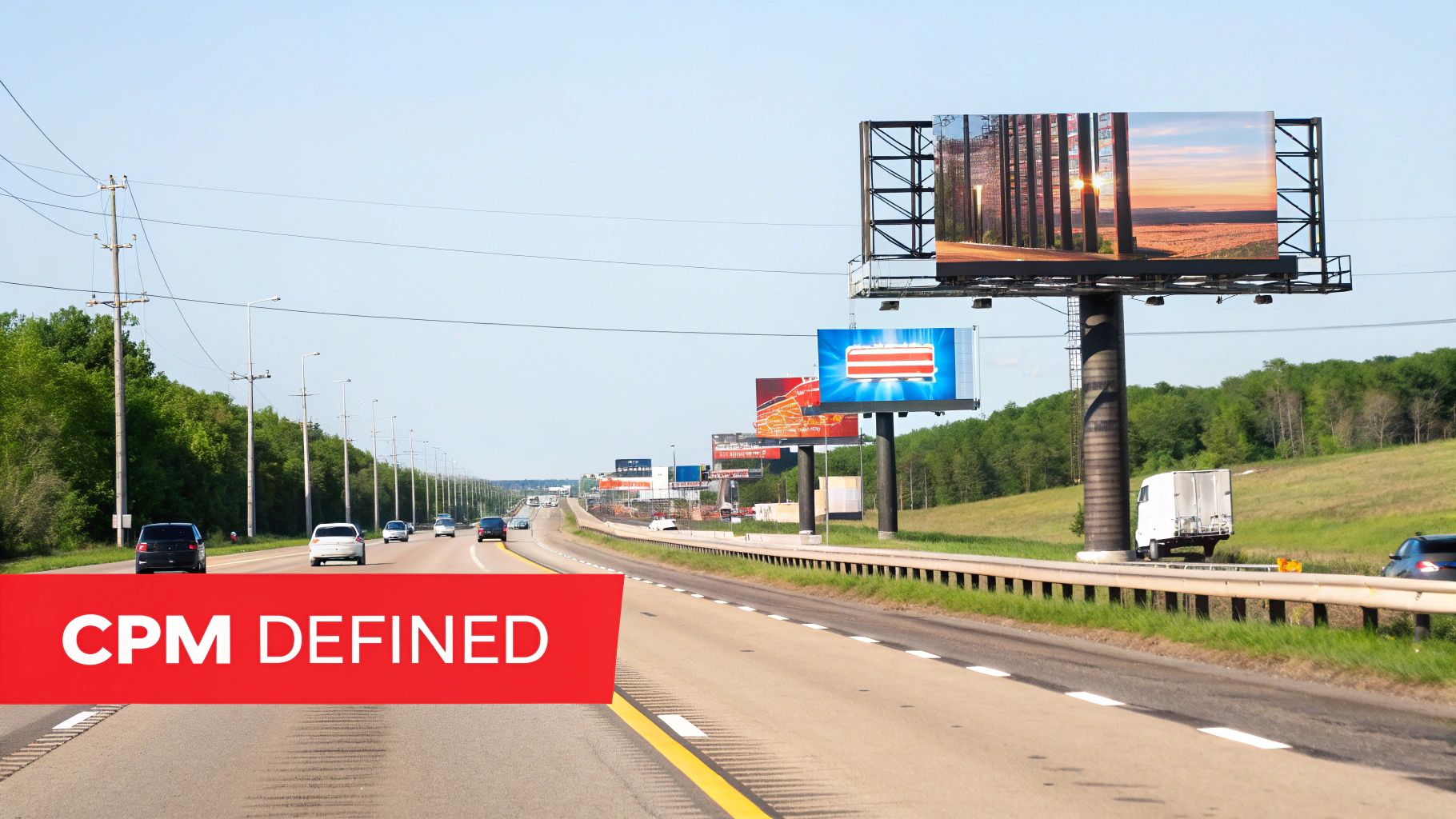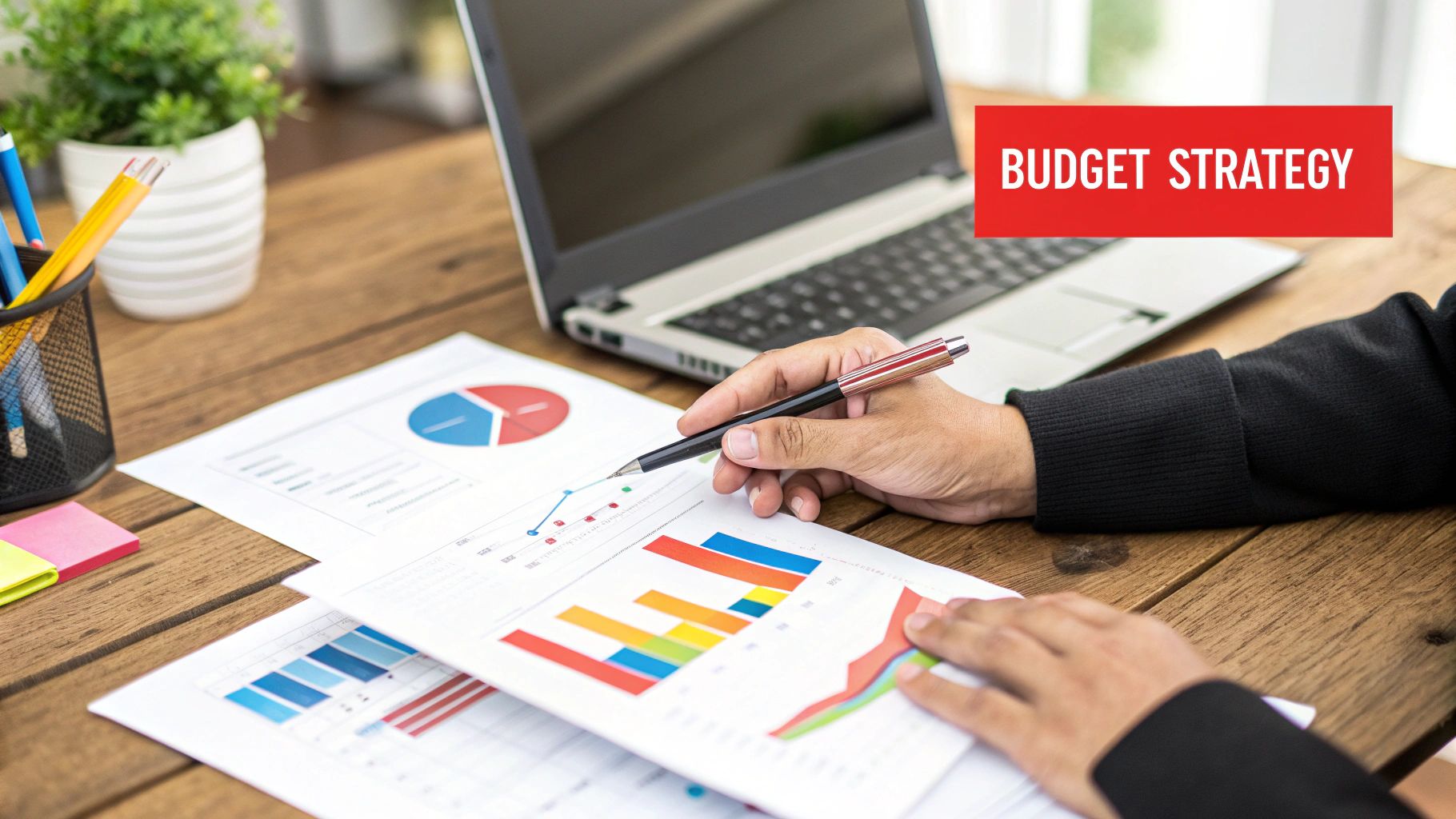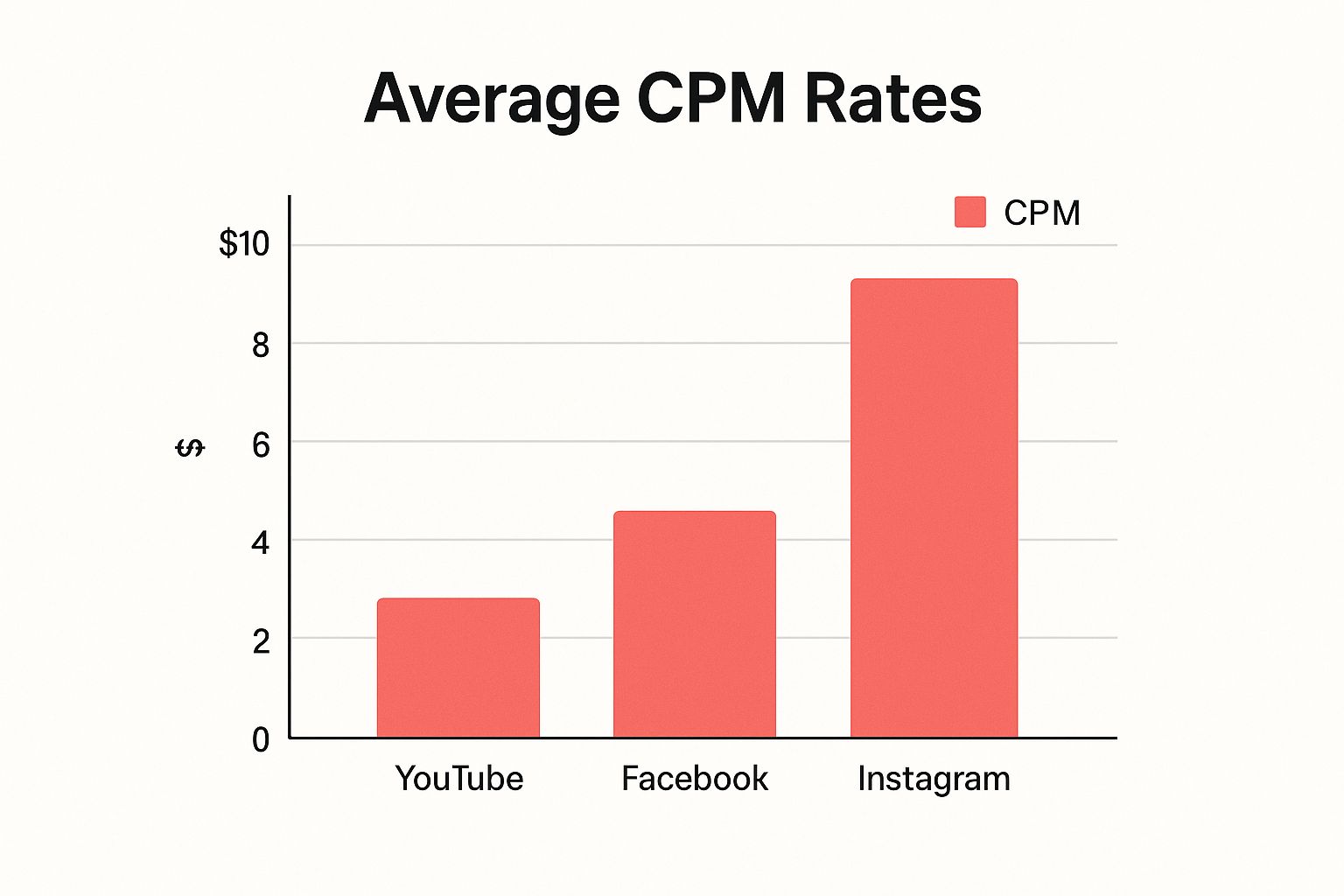Let's peel back the curtain on one of the most fundamental terms in advertising: CPM.
CPM stands for Cost Per Mille. "Mille" is just a fancy Latin word for a thousand. So, in simple terms, CPM is the price an advertiser pays for one thousand views—or impressions—of their ad.
Think of it like renting a digital billboard. You're paying for the potential eyeballs that see your ad, not necessarily for the actions they take afterward. It’s all about visibility.
What CPM Really Means for Your Ad Strategy

At its heart, CPM is your go-to metric for measuring the cost of brand awareness. When you run a campaign based on CPM, your main goal is straightforward: get your brand, your product, or your message in front of as many relevant people as you possibly can.
An impression is counted every single time an ad successfully loads on a user's screen. It doesn't matter if they click it, watch the whole thing, or even consciously notice it. If the ad appears, it's an impression.
Calculating Your CPM
Knowing how to calculate CPM is a game-changer. It's a simple formula that lets you quickly figure out how cost-effective an ad campaign is and compare different platforms side-by-side.
The CPM Formula:
(Total Ad Spend / Total Impressions) x 1000 = CPM
Let's use a real-world example. Say you spent $200 on an ad campaign that got 50,000 impressions.
Here’s the math: ($200 / 50,000) x 1000 = $4.00 CPM.
This means you paid exactly $4.00 for every thousand times your ad was displayed. Simple as that.
To help break it down even further, here's a quick reference table.
CPM at a Glance Key Concepts Explained
| Term | Simple Definition | What It Measures |
|---|---|---|
| CPM | Cost Per Mille (Thousand) | The cost to an advertiser for 1,000 ad impressions. |
| Impression | One single ad view | Each time an ad is successfully displayed on a screen. |
| Total Ad Spend | Your total campaign budget | The full amount of money you invested in the ad. |
This table simplifies the core ideas, giving you a clear snapshot of how CPM works without getting bogged down in jargon.
Why This Metric Matters
This pricing model has been a staple in advertising since it was adapted for the web back in the mid-1990s. It created a standardized way to buy and sell ad space online, much like how traditional newspapers or TV stations priced their ad slots.
For new creators and businesses, getting a handle on CPM is a critical first step. If you're just starting to navigate this world, our digital marketing for beginners guide is a great place to build more foundational knowledge.
So, when is CPM the right tool for the job? It shines in campaigns focused on:
- Building brand awareness: Getting your name out there and introducing your brand to a totally new audience.
- Announcing a new product: Generating that initial buzz and making sure people see what's new.
- Promoting an event: Spreading the word far and wide to ensure a large number of people see the announcement.
Today, modern ad buying, especially through automated systems like programmatic advertising, relies heavily on CPM. These systems use it to purchase millions of impressions at scale, making it an incredibly powerful tool for reaching huge audiences efficiently.
Why CPM Is a Game Changer for Your Budget

Knowing what CPM means is just the first step. The real magic happens when you understand why it’s so critical, whether you're the one buying ad space or the one selling it. Think of CPM as the universal currency for online attention—it gives advertisers and creators a shared language to talk about value.
For advertisers, CPM is your best friend when planning brand awareness campaigns. It brings predictability to the table. You know exactly what you’ll pay for every 1,000 sets of eyes on your ad, which makes it incredibly simple to forecast spending and manage your budget.
This metric also lets you compare apples to apples across different platforms. Is it more cost-effective to reach 1,000 people on YouTube or Facebook? CPM gives you the hard numbers to decide where to place your digital billboard for the most bang for your buck.
A Creator's Engine for Revenue
If you're a content creator, CPM is the engine that powers your ad revenue. Plain and simple, it’s the number that determines how much money you make from all those views you're pulling in. A higher CPM means more cash in your pocket for the exact same amount of traffic.
Let’s say you’re a YouTuber with a popular channel dedicated to cooking tutorials. Last month, your videos racked up 1,000,000 ad impressions. If your CPM was $15, you would have earned $15,000 in gross ad revenue.
This simple calculation is everything. It helps you estimate your monthly income, keep an eye on your channel's financial health, and see just how valuable your audience is to advertisers.
This ability to predict your earnings helps you make smarter business moves, like deciding whether it's time to invest in a new camera or hire an editor. To get a better handle on the math, you can dig into our guide on how to calculate CPM and see how it applies to your own work.
Valuing Your Audience
At the end of the day, your CPM tells a powerful story about your content and the community you’ve built. Advertisers will happily pay more to get their ads in front of specific, valuable audiences—and that's what pushes your CPM up. It's direct proof that your hard work has paid off.
Several key factors influence this number:
- Audience Demographics: An audience primarily in a high-spending country like the United States will naturally have a higher CPM.
- Content Niche: A channel about personal finance or tech will usually command a higher CPM than one focused on general entertainment or gaming.
- Engagement: A highly engaged and loyal audience is a magnet for brands, which leads to better ad rates over time.
By understanding what drives your CPM, you can fine-tune your content strategy to not only delight your audience but also maximize your income. It's one of the most important metrics for running the business side of your creative passion.
Comparing CPM Rates Across Major Platforms
So, you've got a handle on what CPM is. Now for the fun part: seeing how it actually works in the wild.
The truth is, not all platforms are created equal. The price for a thousand impressions can swing wildly from one social network to another. Think of it like buying ad space in the real world—a billboard in Times Square is going to cost a heck of a lot more than one on a quiet country road. Same principle applies online.
The cost to reach your audience depends entirely on where they hang out, what they're doing, and how much attention they're paying. Things like audience demographics, the type of ad you’re running, and even the device they’re using can make your CPM jump or fall.
This chart gives you a quick visual breakdown of average CPM rates across the big players.

As you can see, platforms where people are really locked in or are browsing for professional reasons tend to pull in higher CPMs. It all comes down to how much value advertisers think they're getting from those eyeballs.
Why Do Rates Differ So Much?
So, what causes these massive price gaps? A few key things.
A platform like YouTube, with its longer videos, often has higher CPMs because advertisers will happily pay more for a viewer's focused attention. The type of content is a massive driver, too. For instance, our YouTube CPM by category guide shows just how much more finance or tech channels can earn compared to entertainment.
On the flip side, something like the Google Display Network, which throws banner ads across millions of websites, usually has lower CPMs. The reach is huge, but the ads are less immersive, so each impression costs less.
Key Takeaway: The value of an impression is all about context. An ad someone watches during a ten-minute educational video is just naturally more valuable to a brand than a banner ad they barely notice while scrolling a news feed.
Social media platforms like Facebook, Instagram, and TikTok each have their own pricing quirks. Their rates are heavily swayed by how precisely you can target your audience and the ad formats they offer, whether it’s a simple image in the feed or a snappy video Story.
A Look At Average CPM Benchmarks
While CPM rates are always changing, knowing the general benchmarks helps you set realistic budgets as an advertiser or revenue goals as a creator. Here’s a quick look at what you can generally expect.
To make this easier to compare, here's a table that breaks down the typical CPM rates and what drives them on each platform.
Typical CPM Rates by Advertising Platform
| Platform | Average CPM Range | Primary Influencing Factors |
|---|---|---|
| YouTube | $8 - $30+ | Niche (finance, tech), viewer location (Western countries), ad format (skippable vs. non-skippable). |
| $8 - $15 | Campaign objective (awareness vs. conversion), ad placement (Feed, Stories, Messenger), audience targeting. | |
| $7 - $14 | Ad format (Reels, Stories, Feed), audience engagement, industry (e.g., fashion, beauty). | |
| TikTok | $4 - $10 | Audience demographics (younger), ad format (In-Feed, TopView), creative performance. |
| Google Display Network | $1 - $4 | Website quality and category, ad size and placement, targeting method (contextual vs. audience). |
It's important to remember these numbers are just averages. The ad market is a living, breathing thing, influenced by things like holiday shopping seasons and how many ad slots are available at any given time.
For example, in Q4 of 2023, the average CPM for social media advertising was around $6.06, a perfect example of how market-wide conditions can push prices around.
By getting a feel for these differences, both advertisers and creators can start making much smarter decisions about where to spend their money and focus their efforts.
The Hidden Factors That Drive Your CPM
Your CPM rate isn't some number pulled out of a hat. It's the end result of a massive, real-time auction, and a whole bunch of different variables can make it swing wildly. When you start to understand what's really going on behind the scenes, you can finally see why your rates go up and down.
Think of your channel or website as digital real estate. A billboard in Times Square is going to cost a heck of a lot more than one on a quiet country road, right? The same principle applies here. Some audiences and content niches are simply prime real estate, and advertisers will pay top dollar for a spot.
Once you get a handle on these factors, you can stop guessing and start making smart moves to actually increase what you earn.
The Power of Audience Geography
Where your audience lives is probably the single biggest lever affecting your CPM. It’s simple economics: advertisers will pay way more to reach people in countries with strong economies and a habit of spending money online.
An eyeball on your content from someone in the United States, Canada, or Australia is often worth a lot more than one from a developing nation. Why? Because advertisers are betting that a viewer from a high-income country is more likely to click "buy." That makes the ad space in front of them more competitive and, you guessed it, more expensive.
This is a big reason you might see your CPM shift if you suddenly get a surge of viewers from a new part of the world.
Why Your Content Niche Matters
The topic you cover sets the stage for the ads, and believe me, not all stages are created equal. Someone watching a video about picking stocks or managing a budget is already thinking about money. That makes them the perfect audience for ads about high-end financial products.
This is exactly why certain niches are cash cows for creators:
- Finance and Investing: You've got banks, trading platforms, and software companies with deep pockets all competing for ad space.
- Technology: People watching reviews of the latest $2,000 laptop are a dream audience for tech brands.
- Health and Fitness: This niche is a magnet for advertisers selling supplements, workout gear, and wellness programs.
On the flip side, something broad like comedy or gaming vlogs might have lower CPMs. The audience is huge, but the products being advertised often have a lower price tag, which means advertisers can't afford to bid as high.
Seasonality and Advertiser Demand
The ad world lives and dies by the calendar. Demand for ad space isn't a flat line; it's a rollercoaster that follows consumer behavior throughout the year.
The last three months of the year (Q4) are the Super Bowl for advertisers. With Black Friday and the holiday shopping frenzy, companies throw money at ads to get in front of shoppers. Competition skyrockets, and so do CPMs.
Then comes January. The party's over, marketing budgets have just reset, and CPMs often take a nosedive. It’s a classic post-holiday slump. Smart advertisers, however, look for trends within these seasons. For example, consumer spending often ramps up in mid-November, but CPM rates haven't hit their peak yet, creating a sweet spot. To get a better feel for these cycles, you can dig into the data on seasonal social media ad costs at guptamedia.com.
Key Insight: Your CPM is a direct reflection of market demand. When advertisers are fighting over your audience, your rates go up. When they pull back, your rates follow.
And there's more that goes into the mix:
- Ad Placement and Viewability: Where does the ad show up? An ad that's immediately visible when a page loads or a pre-roll ad that has to be watched will always earn more than one buried at the bottom of a page.
- Device Type: It might sound strange, but viewers on desktop computers often bring in higher CPMs than mobile users. The thinking is that someone at a computer is more likely to do research and complete a complicated purchase.
By seeing how all these pieces fit together, you can move from just watching your CPM to actively working to improve it.
Choosing the Right Model: CPM vs. CPC vs. CPA
Understanding CPM is a great start, but it's just one piece of the digital advertising puzzle. To really get your strategy humming, you need to know when to use it and when its cousins—Cost Per Click (CPC) and Cost Per Action (CPA)—are the better tool for the job.
It all boils down to one simple question: What are you really trying to accomplish?
Let's imagine you're launching a brand-new local café. Each pricing model helps you achieve a different goal. There's no single "best" choice, only the right choice for what you need right now.
CPM for Brand Awareness
CPM (Cost Per Mille) is all about making a big splash. Think of it as blanketing the town with flyers for your new café. You’re paying to get those flyers into as many hands as possible, making sure thousands of people see your name and logo.
The goal here isn't immediate sales. It’s about building recognition. You want your café to be the first place that pops into someone’s head when they think about grabbing a coffee. CPM is perfect for grand openings, announcing a new menu, or just embedding your brand into the local community's mind.
CPC for Driving Traffic
CPC (Cost Per Click) is your go-to when you want people to do more than just see your ad. You want them to take the next step. In our café analogy, this is like paying only when someone stops, takes your flyer, and actually starts reading it.
This model is ideal when your primary objective is to get people to your website, blog, or a specific landing page. You aren't just paying for eyeballs; you're paying for a genuine flicker of interest. It’s a great fit if you want to grow your email list, get more readers for your latest blog post, or have people check out your full menu online.
Key Difference: With CPM, you pay for exposure. With CPC, you pay for engagement. It’s the difference between someone driving past your billboard and someone pulling over to get a closer look.
CPA for Driving Sales
Finally, there's CPA (Cost Per Action), the most performance-focused model of the three. This is like paying only when someone who took your flyer actually walks into the café and buys a latte. You’re tying your ad dollars directly to a valuable result.
That "action" doesn't have to be a purchase. It could be anything you define as a win: a newsletter sign-up, an app download, or a filled-out contact form. CPA campaigns are laser-focused on conversions, making them a fantastic choice for businesses that need to see a clear return on their ad spend. Understanding the nuances of this model is key, and diving into a detailed AdWords Target CPA tutorial can give you a serious edge in optimizing your campaigns for these specific outcomes.
By getting clear on whether your goal is awareness, traffic, or sales, you can confidently pick the right model for your campaign. This ensures every dollar in your advertising budget is working as hard as you are.
Actionable Strategies to Boost Your CPM

Knowing what CPM is in advertising is the first step. The real trick is learning how to increase it. As a creator, you have more control than you think over what advertisers are willing to pay to get in front of your audience. A few smart changes to your content and ad setup can make your platform much more valuable.
These strategies aren't rocket science, but they do require you to think like an advertiser. Your goal is to create a premium environment where brands feel good about placing their ads. When you succeed, your revenue goes up. Simple as that.
Create High-Quality and Brand-Safe Content
The bedrock of a high CPM is content that advertisers want to be associated with. This means creating stuff that's not only well-made and engaging but also brand-safe. Advertisers will gladly pay more to make sure their products don't show up next to anything controversial, sloppy, or offensive.
Focus on making videos, articles, or posts that help, inform, or entertain people without dipping into sensitive subjects. A clean, professional vibe attracts the big fish—brands in lucrative fields like finance, tech, and education that have much bigger ad budgets to spend.
Key Insight: Think of your content as the neighborhood where an ad will live. The safer and more appealing the neighborhood, the more brands are willing to pay for a spot there. Consistently producing high-quality, advertiser-friendly content is the single most effective way to boost your CPM over time.
This approach builds trust with your audience and, just as importantly, with the ad networks themselves.
Optimize Your Audience and Niche
Let's be blunt: not all audiences are created equal in the eyes of advertisers. As we've covered, viewers from countries with strong economies—like the United States, United Kingdom, Canada, and Australia—bring in much higher CPMs. You can't just magically change where your audience lives, but you can create content that naturally appeals to people in those places.
Finding a profitable niche can also make a huge difference. If you make content about personal finance, technology, or business, you'll attract advertisers selling high-ticket products and services. That means more competition for your ad space and more money for you.
Here are a few things you can start doing right away:
- Dig into your analytics: See which topics and formats are already pulling in a high-CPM audience. Then, make more of that.
- Use targeted language: Weave in keywords, examples, and cultural references that resonate with viewers in those high-value countries.
- Play with ad formats: If you're a video creator, turn on different ad types like mid-rolls, pre-rolls, and end screens. This gives the ad system more opportunities to place ads, which can drive up competition and your CPM. Just don't overdo it—too many ads will annoy your viewers.
Got Questions About CPM? We’ve Got Answers.
As you start wrapping your head around CPM, you’re bound to have some questions. It's totally normal. Let's walk through some of the most common ones that come up for creators.
Is a High CPM a Good Thing?
This is a classic "it depends" situation. The answer is completely different depending on whether you're the advertiser buying the ads or the creator running them on your content.
If you’re an advertiser, a high CPM means you’re paying more to get your ad in front of people. That can sting if you're not getting a great return on that spending. But for a creator? A high CPM is exactly what you want to see. It’s a clear sign that advertisers value your audience and are willing to pay top dollar to reach them, which translates directly to more money for you.
The real trick is striking the right balance. You want to make as much as you can, but you can't sacrifice the viewer's experience to get there.
The Creator's Dilemma: A high CPM is awesome, but not if it comes from plastering your content with so many ads that you alienate your audience. The goal isn't just to make money, but to do it sustainably without driving your fans away.
How Can I Figure Out My Potential Earnings with CPM?
You can actually get a pretty good ballpark figure with some simple math. The formula is a great tool for forecasting what you might earn from ad revenue.
Here’s how it works:
(Total Ad Impressions / 1000) x CPM Rate = Your Estimated Earnings
Let's use a real-world example. Say your content gets 500,000 ad impressions, and your average CPM is $10. Your estimated gross earnings would be $5,000. Just keep in mind, that's the total revenue before the platform (like YouTube or TikTok) takes its share.
Help! Why Did My CPM Suddenly Tank?
First off, don't panic. A sudden drop in CPM happens to almost everyone and usually isn't a sign that you did something wrong. A few different things could be at play.
It might just be the time of year. Ad spending notoriously dips in January after the holiday rush, which can pull CPMs down across the board. It could also be a change in your audience—maybe you're getting more views from countries where advertisers pay less. Or perhaps you've switched to a new content niche that isn't as lucrative. Sometimes, it’s as simple as supply and demand on the ad platform itself.
Ready to skip the slow grind and start earning from day one? MonetizedProfiles offers fully monetized YouTube and TikTok accounts, letting you tap into ad revenue immediately. Check out our selection and kickstart your creator journey at https://monetizedprofiles.com.









